宏观经济学PPT课件第三章- 复制
- 格式:ppt
- 大小:1.47 MB
- 文档页数:15
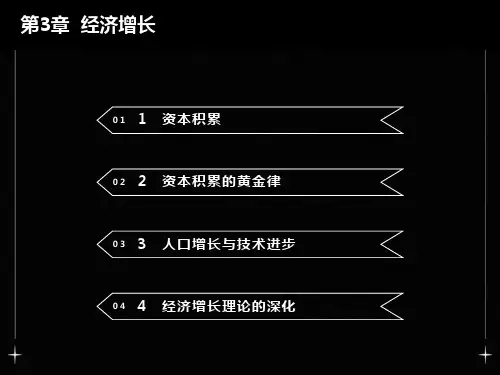

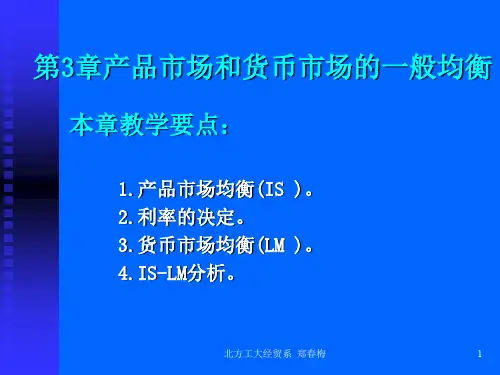
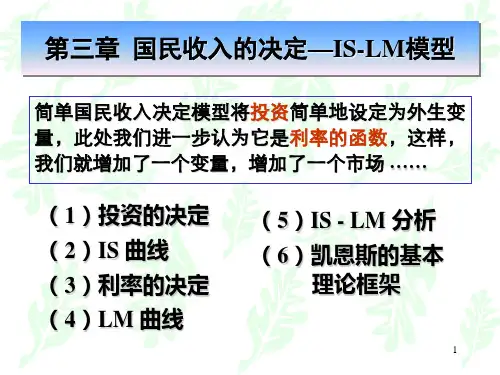


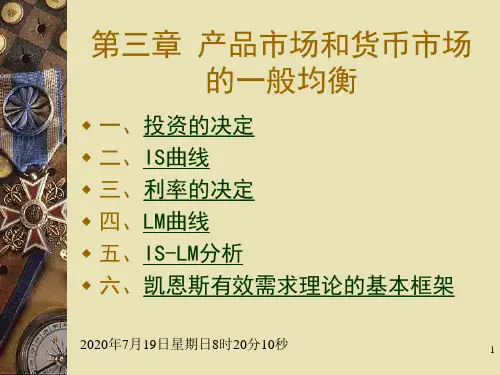
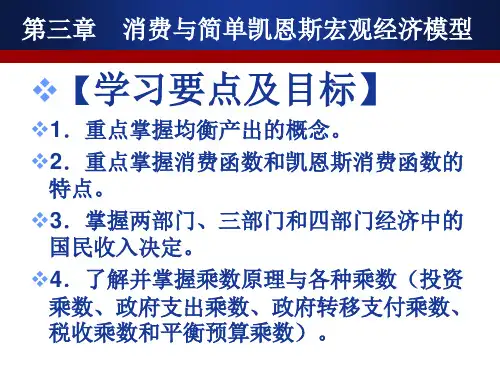



宏观经济学课件chapter03Macroeconomics, 6e (Blanchard/Johnson)Chapter 3: The Goods Market3.1 Multiple Choice Questions1) For the U.S. economy, which of the following represents the largest component of GDP?A) importsB) investmentC) government spendingD) exportsE) none of the aboveAnswer: EDiff: 12) Which of the following types of government spending is included when calculating GDP?A) spending at the federal levelB) spending at the state levelC) spending at the municipal levelD) all of the aboveE) only A and BAnswer: DDiff: 13) Which of the following would NOT be considered part of fixed investment spending (I)?A) Toyota buys a new robot for its automobile assembly line.B) Apple computer builds a new factory.C) Exxon increases its inventories of unsold gasoline.D) An accountant buys a newly built home for herself and her family.E) all of the aboveAnswer: CDiff: 14) Which of the following is true for a "closed economy"?A) government spending equals taxesB) there are no imports or exportsC) exports equal importsD) there is no savingE) there is no government spending or taxesAnswer: BDiff: 15) Which of the following is an exogenous variable in our model of the goods market in Chapter 3?A) consumption (C)B) saving (S)C) disposable income (Y D)D) government spending (G)E) none of the aboveAnswer: DDiff: 26) Which of the following is an endogenous variable in our model of the goods market in Chapter 3?A) consumption (C)B) disposable income (Y D)C) saving (S)D) total income (Y)E) all of the aboveAnswer: EDiff: 27) Disposable income equalsA) income minus saving.B) income minus both saving and taxes.C) consumption minus taxes.D) the sum of consumption and saving.E) none of the aboveAnswer: DDiff: 18) The marginal propensity to consume representsA) the level of consumption that occurs if disposable income is zero.B) the ratio of total consumption to disposable income.C) total income minus total taxes.D) the change in output caused by a one-unit change in autonomous demand.E) the change in consumption caused by a one-unit change in disposable income.Answer: EDiff: 19) Let the consumption function be represented by the following equation: C = c0 + c1Y D. For this equation, we assume that c1 isA) negative.B) larger than c0.C) different at different levels of income.D) equal to one.E) none of the aboveAnswer: EDiff: 110) Suppose the consumption equation is represented by the following: C = 250 + .75Y D. The multiplier in this economy isA) .25.B) .75.C) 1.D) 4.E) 5.Answer: DDiff: 211) Suppose the consumption equation is represented by the following: C = 250 + .75Y D. Given this information, the marginal propensity to save isA) .25.B) .7.C) 1.D) 4.E) none of the aboveAnswer: ADiff: 212) Which of the following occurs when disposable income is zero?A) consumption must be zeroB) saving must be zeroC) saving must be positiveD) consumption is negativeE) none of the aboveAnswer: EDiff: 213) Equilibrium in the goods market requires thatA) production equals income.B) production equals demand.C) consumption equals saving.D) consumption equals income.E) government spending equals taxes minus transfers.Answer: BDiff: 114) An economy is in equilibrium when which of the following conditions is satisfied?A) consumption equals savingB) output equals consumptionC) total saving equals zeroD) total saving equals investmentE) all of the aboveAnswer: DDiff: 115) Which of the following is included in G?A) medicareB) social security paymentsC) interest payments on the government debtD) government purchasesE) all of the aboveAnswer: DDiff: 216) Suppose the consumption equation is represented by the following: C = 250 + .8Y D. The multiplier for the above economy equalsA) 2.B) 3.C) 4.D) 5.E) none of the aboveAnswer: DDiff: 217) Suppose the consumption equation is represented by the following: C = 250 + .75Y D. Now assume government spending increases by 100 for the above economy. Given the above information, we know that equilibrium output will increase byA) 200.B) 400.C) 800.D) 1000.E) none of the aboveAnswer: BDiff: 218) Which of the following will NOT increase equilibrium output in the short run?A) increases in R&DB) increases in consumer confidenceC) increases in investment demandD) increases in government spendingE) decreases in taxesAnswer: ADiff: 219) Which of the following would tend to make the multiplier smaller?A) an increase in the marginal propensity to consumeB) an increase in the marginal propensity to saveC) a reduction in taxesD) a reduction in government spendingE) none of the aboveAnswer: BDiff: 220) Which of the following represents total saving for an economy?A) the sum of private saving and fixed investmentB) the sum of private saving and consumptionC) the sum of taxes and government spendingD) the excess of taxes over government spendingE) none of the aboveAnswer: EDiff: 121) Based on our understanding of the paradox of saving, we know that a reduction in the desire to savewill causeA) an increase in equilibrium GDP.B) a reduction in GDP.C) an increase in the desire to invest.D) no change in equilibrium GDP.E) a permanent reduction in the level of saving.Answer: ADiff: 222) Which of the following events will cause a reduction in equilibrium output?A) an increase in the marginal propensity to saveB) an increase in taxesC) a reduction in the marginal propensity to consumeD) all of the aboveE) none of the aboveAnswer: DDiff: 223) Based on our understanding of consumption and saving, we know that the marginal propensity to consume and themarginal propensity to save mustA) be equal to each other.B) sum to exactly one.C) sum to less than one.D) sum to more than one.E) be equal to the multiplier.Answer: BDiff: 124) Suppose there is an increase in autonomous consumption. Specifically, suppose c0 increases where C = c0 + c1Y D. This increase in autonomous consumption will cause which of the following to increase?A) equilibrium incomeB) equilibrium disposable incomeC) demandD) all of the aboveE) none of the aboveAnswer: DDiff: 225) If C = 2000 + .9Y D, what increase in government spending must occur for equilibrium output to increase by 1000?A) 100B) 200C) 250D) 500E) 1000Answer: ADiff: 226) Which of the following equals demand in an open economy?A) C + I + G + XB) C + I + G + X - IMC) C + I + G + IM - XD) C + I + GAnswer: BDiff: 127) Which of the following equals demand in a closed economy?A) C + I + G + XB) C + I + G + X - IMC) C + I + G + IM - XD) none of the aboveAnswer: DDiff: 128) Suppose an open economy is in equilibrium. Given this information, we know with certainty thatA) G = T.B) X = IM.C) S = I.D) Y = Z.Answer: DDiff: 129) For a closed economy, which of the following conditions must be satisfied for equilibrium to be maintained?A) G = TB) X = IM = 0C) C = SD) none of the aboveAnswer: DDiff: 230) Autonomous spending in a closed economy equals which of the following?A) c0 + I + G - c1TB) C + I + GC) ZD) c0 + I + G + c1TAnswer: ADiff: 231) Based on our understanding of the model presented in Chapter 3, we know that an increase in c1 (where C = c0 + c1Y D) will causeA) the ZZ line to become steeper and a given change in autonomous consumption (c0) to have a smaller effect on output.B) the ZZ line to become steeper and a given change in autonomous consumption (c0) to have a larger effect on output.C) the ZZ line to become flatter and a given change in autonomous consumption (c0) to have a smaller effect on output.D) the ZZ line to become flatter and a given change in autonomous consumption (c0) to have a larger effect on output.Answer: BDiff: 232) Based on our understanding of the model presented in Chapter 3, we know that a reduction in c1 (where C = c0 + c1Y D) will causeA) the ZZ line to become steeper and a given change in autonomous consumption (c0) to have a smaller effect on output.B) the ZZ line to become steeper and a given change in autonomous consumption (c0) to have a larger effect on output.C) the ZZ line to become flatter and a given change in autonomous consumption (c0) to have a smaller effect on output.D) the ZZ line to become flatter and a given change in autonomous consumption (c0) to have a larger effect on output.Answer: CDiff: 233) An increase in the marginal propensity to save from .3 to .4 will causeA) the ZZ line to become steeper and a given change in autonomous consumption (c0) to have a smaller effect on output.B) the ZZ line to become steeper and a given change in autonomous consumption (c0) to have a larger effect on output.C) the ZZ line to become flatter and a given change in autonomous consumption (c0)) to have a smaller effect on output.D) the ZZ line to become flatter and a given change in autonomous consumption (c0) to have a larger effect on output.Answer: BDiff: 234) A reduction in the marginal propensity to save from .4 to .3 will causeA) the ZZ line to become steeper and a given change in autonomous consumption (c0) to have a smaller effect on output.B) the ZZ line to become steeper and a given change in autonomous consumption (c0) to have a larger effect on output.C) the ZZ line to become flatter and a given change in autonomous consumption (c0) to have a smaller effect on output.D) the ZZ line to become flatter and a given change in autonomous consumption (c0) to have a larger effect on output.Answer: CDiff: 235) An increase in the marginal propensity to save from .1to .2 will causeA) an increase in the multiplier and a given change in autonomous consumption (c0) to have a smaller effect on output.B) an increase in the multiplier and a given change in autonomous consumption (c0) to have a larger effect on output.C) a reduction in the multiplier and a given change in autonomous consumption (c0) to have a smaller effect on output.D) a reduction in the multiplier and a given change in autonomous consumption (c0) to have a larger effect on output.Answer: CDiff: 236) When the economy is in equilibrium, we know with certainty thatA) public saving equals investment.B) private saving equals investment.C) G = T.D) none of the aboveAnswer: DDiff: 137) When a closed economy is in equilibrium, we know with certainty thatA) I = S + (T-G).B) I = S.C) I = S + (G-T).D) G = T and S = I.Answer: ADiff: 138) An increase in the desire to save by households will causeA) a reduction in output.B) a reduction in investment.D) no change in investment and no change in output.Answer: ADiff: 239) An increase in taxes will causeA) a reduction in investment.B) an increase in investment.C) no change in investment.D) no change in autonomous spending.Answer: CDiff: 240) A tax cut will causeA) a reduction in investment.B) an increase in investment.C) no change in investment.D) no change in autonomous spending.Answer: CDiff: 241) Based on our understanding of the model presented in Chapter 3, we know with certainty that an equal and simultaneous increase in G and T will causeA) an increase in output.B) no change in output.C) a reduction in output.D) an increase in investment.Answer: ADiff: 342) Based on our understanding of the model presented in Chapter 3, we know with certainty that an equal and simultaneous reduction in G and T will causeB) no change in output.C) a reduction in output.D) an increase in investment.Answer: CDiff: 343) Based on our understanding of the model presented in Chapter 3, a reduction in investment will causeA) an increase in the multiplier.B) a reduction in the multiplier.C) a reduction in the marginal propensity to save.D) a reduction in output.E) both B and DAnswer: DDiff: 244) Suppose business confidence decreases causing a reduction in investment. Based on our understanding of the model presented in Chapter 3, we know with certainty that a reduction in investment will causeA) an increase in the multiplier.B) a reduction in the multiplier.C) a reduction in the marginal propensity to save.D) a reduction in consumption as the economy adjusts to this decrease in investment. Answer: DDiff: 245) Suppose the marginal propensity to consume equals .8(i.e., c1 = .8). Given this information, which of the following events will cause the largest increase in output?A) G increases by 200B) T decreases by 200C) I increases by 150D) both A and BAnswer: ADiff: 346) Inventory investment refers toA) the difference between production and sales in a given year.B) fixed investment.C) nonresidential investment.D) the purchase by firms of new machines.Answer: ADiff: 347) Suppose the consumption equation is represented by the following: C = 250 + .75Y D, then private savings isA) -250+0.25Y D.B) -250+0.75Y D.C) -1000+0.25Y D.D) -1000+0.75Y D.Answer: ADiff: 348) Which of the following about IS relation is NOT correct?A) It is the the relation between interest rate and savings.B) It is the equilibrium condition for the goods market.C) It stands for "Investment equals saving."D) It shows what firms want to invest must be equal to what people and the government want to save.Answer: ADiff: 349) If C = 2000 + .9Y D, what decrease in taxes must occur for equilibrium output to increase by 1000?A) 111B) 100C) 1000D) 500Answer: ADiff: 33.2 Essay Questions1) Discuss what is meant by the paradox of saving.Answer: The paradox of saving refers to the effects of an increased desire to save on output and on the final level of saving. The increased desire to save is equivalent to a reduction in consumption. This drop in demand will cause a drop in output. Furthermore, in this simple economy, the final level of saving will equal the initial level of saving. So, an increased desire to save has a negative effect on the economy and has no permanent effect on the level of saving (because S = I in the simple model).2) Suppose the United States economy is represented by the following equations:Z = C + I + G C = 500 + .5Y D T = 600 I = 300Y D = Y - T G = 2000a. Given the above variables, calculate the equilibrium level of output. Hint: First specify (using the above numbers) the demand equation (Z) for this economy. Second, using the equilibrium condition, equate this expression with Y. Once you have done this, solve for the equilibrium level of output. Using the ZZ-Y graph (i.e., a graph that includes the ZZ line and 45-degree line with Z on the vertical axis, and Y on the horizontal axis), illustrate the equilibrium level of output for this economy.b. Now, assume that consumer confidence decreases causing a reduction in autonomous consumption (c0) from 500 to 400.What is the new equilibrium level of output? How much does income change as a result of this event? What is the multiplier for this economy?c. Graphically illustrate the effects of this change in autonomous consumption on the demand line (ZZ) and Y. Clearly indicate in your graph the initial and final equilibrium levels of output.d. Briefly explain why this reduction in output is greater than (in absolute terms) the initial reduction in autonomous consumption.Answer: a. Y = 5000. The graph is easy to show.b. Y = 4800; the multiplier is 2.c. Graph.d. When demand falls by 100, firms cut production by 100. As production falls by 100, income falls which causes a subsequent reduction in consumption and demand.This Y-induced fall in demand causes another reduction in production. This continues and we observe a final change in Y that exceeds the initial change in autonomous demand.3) Explain what the multiplier represents.Answer: The multiplier illustrates the extent to which equilibrium output will change as a result of a given change in autonomous demand.4) Discuss and explain what effect a reduction in the marginal propensity to consume has on the size of the multiplier.Answer: A reduction in the marginal propensity to consume will cause a reduction in the multiplier. When firms increase production in response to some initial change in demand, households will increase their consumption by a smaller amount when the mpc falls. So, the income-induced change in demandwill be that much smaller causing a smaller multiplier effect.5) Use the ZZ-Y model presented in chapter 3 to illustrate the effects of a reduction in consumer confidence on the economy. Also, explain what effect this reduction in consumer confidence has on the economy.Answer: The graph is easy. The reduction in consumer confidence will cause a reduction in consumption and demand. As demand falls, firms will cut production. So, this event will cause a lower level of equilibrium output.6) Suppose that, at a given level of disposable income, consumers decide to save more. Explain what effect this decision will have on equilibrium income. Also, explain what effect this decision will have on the level of saving once the economy has reached the new equilibrium.Answer: This is the paradox of saving. Here, consumption will fall causing a reduction in demand and a reduction in output. Despite the initial increase in saving at the initial level of income, saving will return to the initial level as income falls in order to maintain the alternative equilibrium condition: S = I. So, the initial increase in the desire to save will have no permanent effect on the level of saving.7) Explain the difference between endogenous and exogenous variables.Answer: Endogenous variables are determined by the model. Exogenous variables are taken as given and, for example in this model, do not change as income changes.8) Discuss the two components of fixed investment.Answer: Nonresidential investment represents the purchase of new equipment and structures. Residential investment represents the purchase by people of new homes, condos, andapartments.9) For this question, assume that taxes are independent of income (i.e., the income tax rate is zero). Now suppose that fiscal policy makers wish to decrease equilibrium output by $500 billion. Further suppose that policy makers can choose one of the following two options: (1) change in government spending; or (2) change in taxes. Compare and explain the relative size of the changes in government spending and taxes needed to obtain this desired change in output. Answer: The change in taxes will have to be larger because part of any tax increase will cause saving to fall. So, to cause the same reduction in demand, the size of the tax cut will have to be larger than the size of any reduction in government spending.10) Explain what factors cause shifts and changes in the slope of the ZZ curve presented in chapter 3.Answer: The ZZ curve is upward sloping. The ZZ curve illustrates the level of demand at each level of income. As Y increases, households consume more causing an increase in demand. So, as Y rises, so does demand. The marginal propensity to consume will determine the size of the slope. The ZZ curve will shift when any autonomous component of demand changes. This will include changes in T, G, I and c0.11) Why would consumer decrease consumption even if their disposable income has not changed?Answer: If consumers start worrying about the future and decide to save more, they will decrease c0 and hence consumption. This is what happened at the start of the most recent financial crisis.12) In the model discussed in Chapter 3, why do we assumeG and T are exogenous?Answer: It is based on two arguments: First, government do not behave with the same regularity as consumers or firms, so there is no reliable rule we could write for G or T. Second, treating G and T as exogenous help explore the implications of alternative spending and tax decisions.13) Suppose the United States economy is represented by the following equations:Z = C + I + G C = 500 + .5Y D T = 600 I = 300Y D = Y - T G = 2000a. Given the above variables, calculate the equilibrium level of output.b. Now, assume that government spending decreases from 2000 to 1900. What is the new equilibrium level of output? How much does income change as a result of this event? What is the multiplier for this economy?Answer: a. Y=5000b. Y=4800, multiplier=2.14) Suppose the United States economy is represented by the following equations:Z = C + I + G C = 500 + .5Y D T = 600 I = 300Y D = Y - T G = 2000a. Given the above variables, calculate the equilibrium level of output.b. Now, assume that taxes increase from 600 to 700. What is the new equilibrium level of output? How much does income change as a result of this event? What is the multiplier for this economy?Answer: a. Y=5000.b. Y=4900, multiplier =2.15) Graphically illustrate the effects of an increase inautonomous consumption on the demand line (ZZ) and Y. Clearly indicate in your graph the initial and final equilibrium levels of output. Briefly explain why this increase in output is greater than (in absolute terms) the initial change in autonomous consumption.Answer: ZZ line will shift upward and Y will increase. The increase in output is greater than the initial change in autonomous consumption is due to the multiplier effect.。